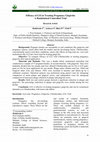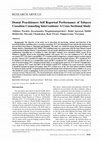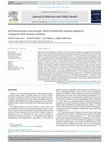Papers by Siddhi Hathiwala

International journal of Ayurvedic medicine, Mar 26, 2013
Background: Pregnant females are susceptible to oral conditions like gingivitis and pregnancy tum... more Background: Pregnant females are susceptible to oral conditions like gingivitis and pregnancy tumour, which affect both the mother and the developing foetus. Chlorhexidine, conventionally used to treat these conditions, causes side effects on long term use. Ayurvedic medications like G32 have been used for treating gingivitis. Objective: To compare efficacy of G32 with Chlorhexidine in treating pregnancy gingivitis after topical application. Materials and Methods: This was a double blind, randomised controlled trial conducted in a sample of 37 pregnant females, in second trimester, with gingivitis. They were randomly divided into two groups and were allotted Chlorhexidine gel (n=18) or G32 gumpaint (n=19) for local application for one month. Plaque index (Silness and Löe, 1964) and Gingival index (Löe and Silness, 1963) were recorded at baseline and follow-up by a calibrated examiner. Statistical analysis was performed using paired t-test for intragroup comparison of mean plaque and gingival scores, and independent t-test for intergroup comparison of mean percentage reduction in plaque and gingival scores. Results: Both test and control groups showed a significant reduction in plaque and gingivitis. The percentage reductions in plaque and gingivitis were similar among the two groups. Conclusion: G32 is effective in treating pregnancy gingivitis and can be economical alternative to Chlorhexidine, with lesser side effects.

JOURNAL OF CLINICAL AND DIAGNOSTIC RESEARCH, 2021
Introduction: Centric Relation (CR) is the only physiological position which is repeatable, recor... more Introduction: Centric Relation (CR) is the only physiological position which is repeatable, recordable and reproducible for prosthodontic rehabilitation. A missed CR can give rise to faulty occlusal relationships leading to a life time of trauma to the temporomandibular joints. Literature has various methods outlined to locate and record the CR but it’s confusing as to which method is best suited to take the condyles into CR position. Hence, this systematic review was conducted to find an answer to this very question. Aim: To find a reliable clinical technique to guide the mandible to a recordable, repeatable and reproducible CR position. Materials and Methods: The present systematic review was conducted from July 2019 to October 2019 at School of Dental Sciences, KIMSDU, Maharashtra. A 20-year comprehensive literature review was undertaken aiming to arrive at a reliable and repeatable method to guide the mandible to CR following the Preferred Reporting Items for Systematic Reviews ...
Journal of International Oral Health, 2018
Aim: The aim of this study was to evaluate the association between the tooth loss impaired chewin... more Aim: The aim of this study was to evaluate the association between the tooth loss impaired chewing ability and cognitive impairment among the elderly of western Maharashtra, India. Materials and Methods: It was a cross-sectional, community-based study conducted among 200 consenting elderly. Information regarding tooth loss, chewing ability and cognitive impairment (clock-drawing test), and sociodemographic variables were obtained and analyzed. Results: Participants with impaired chewing ability had 5.57 more odds of cognitive impairment. Similarly, those with multiple tooth loss had 2.4 times odds of cognitive impairment compared to normal counterparts. Conclusions: Multiple tooth loss and impaired chewing ability increase the odds of cognitive impairment.

Journal of clinical and diagnostic research : JCDR, 2017
Oral malodour is a social malady affecting people of all the age groups. Effective management of ... more Oral malodour is a social malady affecting people of all the age groups. Effective management of oral malodour is the key to improve the quality of life of such people. To evaluate the effectiveness of ayurvedic medication, G32 in controlling oral malodour and comparing the effects with Chlorhexidine (CHX). This was a single blind randomized controlled trial with parallel study design conducted at a hospital in the city of Udupi in Southern India. A total of 40 patients suffering with oral malodour, aged 17-35 years, were included in this trial. After inclusion into the study, the subjects were examined twice, with a one-week interval between both examinations. Volatile Sulphur Compounds (VSCs), gingival, plaque and tongue coating scores were assessed at both examinations. Subjects were randomly allocated to G32 group - ayurvedic formulation (intervention group) and CHX group (control group), and were provided with the respective formulations enough to be used twice daily for a peri...

Asian Pacific Journal of Cancer Prevention, 2013
Background: The objective of the study was to determine the knowledge, attitude and behaviors of ... more Background: The objective of the study was to determine the knowledge, attitude and behaviors of the practicing dentists regarding tobacco cessation counseling (TCC) in Chhattisgarh state and also the barriers that prevent them from doing so. Materials and Methods: The study was conducted among dental practitioners of Raipur district, Chhattisgarh state (India). The sampling frame was registration with the State Dental Council and practicing in Raipur district. A questionnaire was personally administered and the practitioners were given explanations regarding how to complete it. Only descriptive statistics were calculated (SPSS version 16 for Windows). Results: Based on the responding dentists' self reports, 76% were not confident in TCC, 48% did not assume TCC to be their responsibility, 17% considered that it might have a negative impact on their clinical practice, whereas 24% considered it might take away precious time from their practice, 25% considered TCC by dentists to be effective to a considerable extent and 80% considered TCC activities are not effective due to lack of formal training, 69% considered dental clinics as an appropriate place for TCC but 82% thought there must be separate TCC centre and 100% of the dentists wanted TCC training to be a part of practice and that it should be included in dental curriculum. Some 95% of them were of the view that tobacco products should be banned in India and 86% responded that health professionals must refrain from tobacco habits so to act as role models for society. Conclusions: Dental professionals must expand their armamentarium to include TCC strategies in their clinical practice. The dental institutions should include TCC in the curriculum and the dental professionals at the primary and the community health care level should also be trained in TCC to treat tobacco dependence.

MOJ Public Health, 2015
Emails are sent under the ''call for papers'' to various researchers with the incentive of rapid ... more Emails are sent under the ''call for papers'' to various researchers with the incentive of rapid processing and acceptance of articles within period of time ranging from few days to 2 weeks. Usually journals with not very high impact factors, those with individual publisher with single journal, being published in non English language are being targeted. Well known journals like "Vulfenia Journal" , "Archives des Sciences,", Emergencias (an emergency medicine journal from Spain), the Journal of the American Medical Association (JAMA), Vitae-Revista (The Official Publication of the Faculty of Pharmaceutical Chemistry at the University of Antioquia, Colombia), Amala (published by the Amala Cancer Research Center in India), TERAPEVTICHESKII ARKHIV (from Russia), Kardiologiya (from Russia) and Revue Scientifique et Technique (published by the World Organization for Animal Health) have been the recent victims of the same. 4 4. Jalalian M. Hijacked journals are attacking the reliability and validity of medical research.
Journal of Dental Research and Scientific Development, 2016

Journal of Dentistry and Oral Hygiene, 2015
Optimum oral health is required to eat, socialize without discomfort or embarrassment. Untreated ... more Optimum oral health is required to eat, socialize without discomfort or embarrassment. Untreated dental caries is a common problem faced by the population in developing countries affecting the development of the child. A cross sectional study was conducted among 3 to 5 years old preschool children to evaluate the prevalence of dental caries and consequences of untreated dental caries. Dental caries was measured using 'dmf' and 'pufa' index. Descriptive statistics was computed to assess the prevalence of the untreated dental caries. Chi square test and z test were used to assess the statistical difference among the variable means in between the groups. Data was analyzed using SPSS ver 20.0. The prevalence of dental caries in the study population was 32% and that of the untreated dental caries with clinical consequences was 24%. There was no statistically significant difference between the genders for prevalence of untreated dental caries. The mean 'dmf' and 'pufa' scores increased over the ages of 3, 4 and 5 years in the study sample. 'pufa' index can be used as a useful epidemiological tool to assess the prevalence of untreated dental caries. Proportion of untreated dental caries was substantial which points to the need for diverting attention to care of deciduous dentition.

Journal of the Indian Society of Pedodontics and Preventive Dentistry
Dental treatment can be highly unpleasant for anxious patients. Despite all advancements, dental ... more Dental treatment can be highly unpleasant for anxious patients. Despite all advancements, dental anxiety continues to upset the dentist-patient relationship. The psychological factors like individual personality and familial and peer influence may alter the dental beliefs of a patient. A cross-sectional questionnaire study was conducted among young adolescents to investigate the relationship among various psychological factors and the dental beliefs of an individual. A self-administered questionnaire was distributed among higher secondary school children, aged 15-17 years in Udupi district. The dental anxiety of the participants was measured using Modified Dental Beliefs scale and the personality traits were assessed using the Ten-Item Personality Inventory. Pearson's correlation and chi-square analysis were performed among these scales. Independent t-test was performed to compare dental anxiety scores with different socio-demographic and psychological characteristics. In all 19...

Journal of Infection and Public Health, 2017
Rapid and accurate diagnosis of malaria is the need of hour for effective management and controll... more Rapid and accurate diagnosis of malaria is the need of hour for effective management and controlling drug resistance. The conventional and gold-standard method, Light microscopy (LM), is time-consuming, requires trained staff and well-maintained equipments. The newly developed, rapid diagnostic tests (RDT) are fast and reliable, but give only qualitative results, are expensive and have short shelf life. Light Emission Diode fluorescence microscopy (LED FM) may provide a reliable alternative which can be used for routine diagnosis. In order to assess the effectiveness of LED fluorescence microscopy in malaria diagnosis, a cross-sectional study was conducted at a tertiary care teaching hospital in Mumbai. 2-3 ml of blood of 300 patients, who were clinically suspected of having malaria but were not on anti-malarial treatment, was collected in EDTA vials. These specimens were processed to diagnose malaria by three methods, namely-Peripheral smear examination with LM, Peripheral smear examination with LED FM and RDT. The results of all the 3 tests were compared, taking Light Microscopy as the gold standard method. Of the 300 specimens, LM, LED FM and RDT reported 111 (37%), 86 (28.67%) and 107 (35.67%), respectively, as positive. The sensitivity and specificity were respectively 71.2% and 96.3% for LED FM and 91% and 96.8% for RDT. Of the LM positive cases, 53 (47.75%) had parasitic index (PI) <1% and 58 (52.25%) had PI ≥1%. LED FM was found to be only moderately sensitive but highly specific in comparison to Light microscopy. In order to improve the performance of this technique, more precise training in fluorescence staining and reading of the slides, will be required.

Uploads
Papers by Siddhi Hathiwala